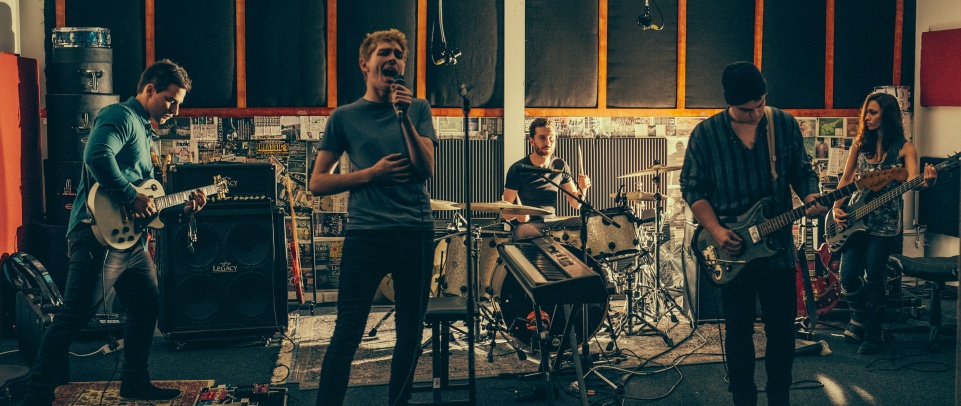How to Rehearse Your Band
by T. Perry Bowers
I’ve owned and operated rehearsal space facilities for over 15 years. I’ve seen a lot of bands come and go. I’ve heard many bands practicing in their spaces over the years. I’m still surprised and impressed by some of the techniques. I can usually tell when a band isn’t going to last long. The premonition often comes when I hear their rehearsal style. I hear bands “jamming” for an hour or so and then I see them outside taking a smoke break. Then, I hear them “jamming” again. I witness this for a couple of weeks and then I get their 30 day notice. It could be a lot of things. It could be the dynamic between the members. It could be that the songs aren’t being arranged in interesting and compelling ways. It could be that their skills aren’t well matched. But, usually, it’s just a lack of structure and an unwillingness to practice fundamentals. Jamming can be fun for a session or two, but it quickly gets old unless skills are improving and songs are coming together.

Don’t Skip the Fundamentals:
1. The Click Track
I also run a recording studio. I’m always relieved when the band that is about to hire me, tells me that they are solid with a metronome. This makes my life and their life so much easier during the course of recording. This also applies to rehearsal. My son started a band when he was 14 years old. He had already been playing the cello for about 5 years. Part of his cello practice was playing with a metronome, so he had good timing at an early age. The same went for the boys with whom he formed the band. These guys always practice with a click. Sometimes I walk into their room when they are practicing and my ears almost start to bleed from the piercing sound of the metronome coming from the PA system. This has become an integral part of their practice strategy. It keeps them tight and allows the songs to breathe like they should. Of course, there is a time and a place for a tempo shift within a song, but 99% of songs should be played at one tempo from the beginning to the end.
Playing with a metronome in a rehearsal space takes a little effort. All musicians have to be able to clearly hear the click, so it is good to position the PA monitors where the sound can go directly into your ears. I recommend floor monitors in a rehearsal room. If you have regular “main” speakers, try to get them up off the ground on a stand or shelf. Having them on the floor can help with feed back because the microphones and the speakers are not on the same level. Having the speakers up high can help because the volume can be lower on the amp/mixer itself. Just experiment with positions until the feedback is limited and the click (and the vocals) can be heard. This probably will involve turning down your guitars for a while. Until all members of the band get skilled at playing to a click, it is useful to play quietly. You may not be able to attain the perfect tone on your amps. You may not be able to express yourself on the drums like you do when you’re “jamming”. This is going to be uncomfortable for a while, but trust me, all of the frustration is worth it. When I was disciplining myself to play with a metronome, I kicked over my drums more than once. It’s not easy. I often hear excuses for people’s inability to practice with a click. People say, “it doesn’t feel right with a click” or “we groove better without a click”. I just hear, “We’ve never disciplined ourselves to play to a click and we’re not about to do it now”. Just do it.
2. Be in Tune
Guitar Center sells a lot of tuners. I bet they sell at least one with every guitar that goes out the door. And I know musicians use them. But, guitars are still out of tune. Even if they are brand new, most guitars that come out of a guitar shop are not properly set up. There are a few reasons for that. One, the factory doesn’t really set them up in the first place. Second, they’ve been on a long journey and by the time it makes its way into the final customer’s hands, its been played by a lot of people. And lastly, everyone is different. I had a 1977 Stratocaster for years. It sounded cool except when I played a G chord. My bottom E string would just sound sour. I thought it was the intonation of the guitar. I took it to a few guitar repair shops and they all gladly took my money, intonated it and gave me a brand new set of strings. But, it still sounded the same. I finally met Kenny Rardin, who suggested I put heavier strings on the bottom 3. He said I was probably pushing too hard when I formed a G chord and it was making that string go out of tune. Well, he was right and now my guitars are in tune. Many guitar players have tuning problems that a tuner can’t solve. My advice is keep working on your guitar until it is in tune and stays in tune. Experiment with different size strings. Eliminate the buzz, by getting your action right. Make your guitars sound good. Again, it’s not as easy as it looks.
3. Vocals
What’s the biggest criticism from fans when they see you after you’ve performed a show? I bet it’s “I couldn’t hear the vocals, and I couldn’t understand the words”. I know I’m plenty guilty of that. I grew up on bands like Nirvana, Smashing Pumpkins and My Bloody Valentine where the vocals/lyrics were just a part of the music. They weren’t really meant to be understood or even heard much. Well, unless you’re Nirvana or Pearl Jam in the 90s, you might want to take that criticism to heart. Somehow you’ve got to create a strategy to get your vocals up over the mix and help your singer feel comfortable. This may involve turning your Marshall stack down. I know, that tone! But, when you get on a bigger stage, you can turn it back up. And as far as drums go, in a rehearsal space, the only way to turn down is to play softer. This isn’t easy. Maybe you sacrifice some of your power rolls. Maybe you learn to play more simply. Make the vocals a priority and you won’t be faced with the same frustration by your fans after every gig. Your fans want to hear what you have to sing. They want to relate to you. They want to connect. And that’s what you want too right? So connect already!
4. Structure
When the band comes into the practice space, it is helpful to know what is going to be accomplished. Usually when my band practices, we are either rehearsing for a show or writing new material. If we are rehearsing for a show, we play the set twice. A typical set is 45-60 minutes, so that takes us about 2 hours. We always play our tightest material for a show. Occasionally, we throw in a new song that is not completely fleshed out. We work on a flow for the set as well. I will ad some banter in between songs. I find that it helps find the proper rhythm and it helps me practice talking. We also work on tuning or changing guitars at well placed times, so that there are no surprises at the show.
When we are writing new material, it is a lot more free from. We usually record the sessions and listen to the recordings on our own individual time. Recording and listening back is absolutely key to making progress in the practice space. It hastens the writing process and it will show you what is and is not working. I have used a mini-disk recorder with a simple stereo microphone for a long time. Now, I use a condenser mic with an interface for my iPad. Do your best to make tolerable recordings. If you can afford some nice gear, great. If money is tight, a $10 tape recorder is good enough.
The bottom line is: treat your rehearsals with some respect. Create an environment where you can push the ball forward. This will keep the band morale high, which is so important. Eventually, you will be rewarded by your fans appreciating your progress.

